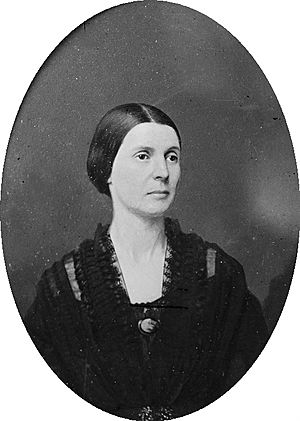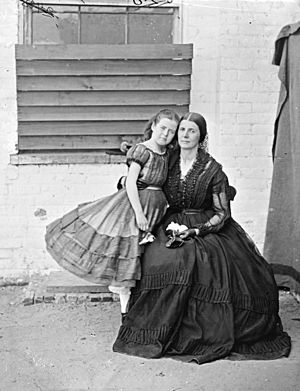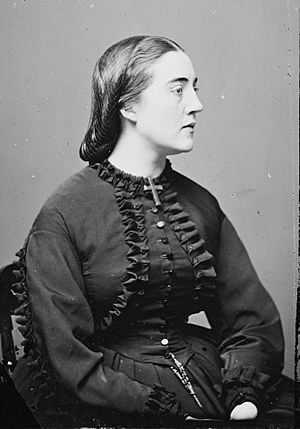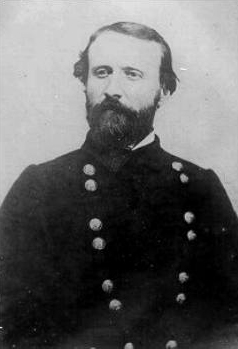Rose O'Neal Greenhow facts for kids
Quick facts for kids
Rose O'Neal Greenhow
|
|
|---|---|
 |
|
| Born | 1813 or 1814 |
| Died | October 1, 1864 (aged 51) |
Rose O'Neal Greenhow (1813– October 1, 1864) was a famous spy for the Confederacy during the American Civil War. Before the war, she was a well-known person in Washington, D.C.. She had many important friends, including presidents, generals, and senators.
Rose used her connections to share important military information with the Confederacy. In early 1861, she took charge of a spy network in Washington, D.C. This network was set up by Thomas Jordan, a Confederate Army captain. Jefferson Davis, the Confederate president, said that Rose helped the South win the First Battle of Bull Run in July 1861.
The government found out that information was being leaked. They traced it back to Rose Greenhow's home. She was put under house arrest. When she kept spying, she was sent to prison in Washington, D.C., in 1862. Her young daughter, "Little Rose," stayed with her. They were in prison for almost five months.
After her release, Rose was sent to the Confederacy. She traveled to Richmond, Virginia, and started new tasks. She sailed to Europe, avoiding Union ships, from 1863 to 1864. Her mission was to represent the Confederacy in France and Britain. In 1863, she also wrote a popular book about her experiences in London. In 1864, her ship ran aground off the coast of Wilmington, North Carolina. She drowned when her small boat overturned while she tried to escape a Union gunboat. She was given a military funeral by the Confederacy.
In 1993, a group called the women's auxiliary of the Sons of Confederate Veterans changed its name. They became the Order of the Confederate Rose to honor Greenhow. This happened after a TV movie about her life came out.
Contents
Early Life
Rose was born in 1813 as Maria Rosetta O'Neale. She grew up on a small farm in Montgomery County, Maryland. Her family was Catholic. Her father, John O'Neale, was a farmer who owned enslaved people. He died in 1817 when Rose was young. Her mother, Eliza Henrietta Hamilton, was left with four daughters and little money.
Around 1830, Rose and her sister Ellen went to live with their aunt in Washington, D.C. Their aunt, Mrs. Maria Ann Hill, ran a popular boarding house. It was located at the Old Capitol Building. The girls met many important people there. Rose had olive skin and a "delicately flushed" face. This earned her the nickname "Wild Rose."
In the 1830s, she met Robert Greenhow Jr. He was a well-known doctor, lawyer, and language expert from Virginia. Their relationship was liked by Washington society. This included famous socialite Dolley Madison. In 1833, Rose's sister Ellen O'Neal married Dolley's nephew, James Madison Cutts. Later, in 1856, their daughter Adele Cutts married Senator Stephen A. Douglas.
Marriage and Family
In 1835, Rose married Dr. Robert Greenhow Jr. She became a well-known socialite in Washington, D.C. Robert Greenhow worked for the U.S. Department of State. Robert's step-sister, Mary Greenhow Lee, often visited them. The two women became close friends.
The Greenhows had four daughters: Florence, Gertrude, Leila, and Rose. Their youngest child was also named Rose O'Neal Greenhow. She was called "Little Rose." In 1871, Little Rose married an Army officer named William P. Duvall.
Robert's job with the State Department led the family to move. They lived in Mexico City in 1850. Then they moved to San Francisco, California. In 1852, Rose returned East with her children. This journey took several months. She gave birth to her last daughter in 1853. Her husband died in an accident in San Francisco in 1854. Even as a widow, Rose remained popular in the capital.
Soon after, their oldest daughter Florence married Seymour Treadwell Moore. He was a West Point graduate and an army officer. The couple moved to Ohio.
Confederate Spy
After her husband died, Rose Greenhow became more supportive of the Confederate cause. She believed in the South's way of life. Her friendship with U.S. Senator John C. Calhoun from South Carolina also influenced her. People in Washington who supported the Confederacy noticed Greenhow's loyalty. She was then asked to become a spy.
Her recruiter was U.S. Army captain Thomas Jordan. He had created a spy network in Washington for the South. He gave her a special code with 26 symbols to write secret messages. After giving Greenhow control of the spy network, Jordan left the U.S. Army. He went South and became a captain in the Confederate Army. He continued to receive and review her reports.
On July 9 and July 16, 1861, Greenhow sent secret messages to Confederate General P. G. T. Beauregard. These messages contained important information about Union Army movements. This included the plans of General Irvin McDowell for the First Battle of Bull Run. Other people helped her, including pro-Confederate members of Congress and Union officers. Confederate President Jefferson Davis said that Greenhow's information helped the Confederates win the battle at Manassas on July 21.
After the battle, she received a telegram from Jordan. It said: "Our President and our General direct me to thank you. We rely upon you for further information. The Confederacy owes you a debt." She became known as "Rebel Rose" for her work.
Capture and Prison

Rose Greenhow knew she was suspected of spying. She worried about her daughters' safety. Her daughter Leila was sent to Ohio to live with her older sister Florence. Only "Little Rose" stayed with Greenhow in Washington.
Allan Pinkerton became the head of the new United States Secret Service. One of his first orders was to watch Greenhow. This was because she knew many people on both sides of the war. On August 23, 1861, Pinkerton arrested Greenhow. He placed her under house arrest at her home. His agents found that other secret information also came from Greenhow's house.
While searching her home, Pinkerton's men found many spy materials. These included pieces of coded messages and maps of Washington's defenses. They also found notes about military movements. The materials also included love letters. These were supposedly from the Republican U.S. Senator Henry Wilson. Greenhow thought he was her best source of information. She claimed he gave her details about the number of guns in Washington's defenses. The papers seized from Greenhow are now kept at the National Archives and Records Administration.
Pinkerton watched all visitors to Greenhow's house. He also moved other suspected Southern supporters into it. This led to the house being called "Fort Greenhow." Pinkerton liked controlling the visitors and messages. This gave him more power over the flow of Southern information. Greenhow complained about her treatment in a letter to a government official. This letter became public. People in the North criticized Pinkerton for being too easy on a spy.
On January 18, 1862, Pinkerton moved Greenhow to Old Capitol Prison. Her youngest daughter, "Little Rose," who was eight years old, was allowed to stay with her. Greenhow was never put on trial.
Greenhow continued to send messages while in prison. People passing by could see her window from the street. Some historians believe that the way her blinds were set, or the number of candles burning, had special meanings for her contacts. Another story says her prison room faced the prison yard. This was so she could not see or be seen. Greenhow also once flew the Confederate Flag from her prison window.
International Travels
On May 31, 1862, Greenhow was released from prison. Her daughter was with her. They were released on the condition that they stay in Confederate areas. They were taken to Fortress Monroe. From there, they went to Richmond, Virginia. Southerners welcomed Greenhow as a hero. President Jefferson Davis was happy she returned. He asked her to be a messenger to Europe.
Greenhow sailed to Europe, avoiding Union ships. From 1863 to 1864, she traveled through France and Britain. Her goal was to gain support for the Confederacy from important people. Many European leaders felt sympathy for the South. There were also strong business ties between Britain and the South.
In France, Greenhow was welcomed by Napoleon III. In Britain, she met Queen Victoria. Greenhow also met, and became engaged to, Granville Leveson-Gower, 2nd Earl Granville in 1864. She wrote about her mission in her personal diaries.
Two months after arriving in London, Greenhow wrote her memoir. It was called My Imprisonment and the First Year of Abolition Rule at Washington. She published it that year in London. It sold very well throughout Britain.
Death
On August 19, 1864, Greenhow left Europe to return to the Confederacy. She was carrying important messages. She traveled on a British ship called the Condor. This ship was used to avoid the Union blockade. On October 1, 1864, the Condor ran aground. This happened at the mouth of the Cape Fear River near Wilmington, North Carolina. A Union gunboat called the USS Niphon was chasing it.
Greenhow feared being captured and imprisoned again. She tried to escape the stuck ship in a rowboat. A wave overturned her small boat. Greenhow drowned. She was weighed down by $2,000 worth of gold. This gold was sewn into her clothes and hung around her neck. It was money she earned from her book.
When Greenhow's body was found, searchers found a small notebook and a copy of her book. Inside the book was a note for her daughter, Little Rose. She was given a military funeral. It was held at St. Thomas the Apostle Catholic Church in Wilmington, North Carolina. In 1888, the Ladies' Memorial Association marked her grave. Her grave in Oakdale Cemetery has a cross that reads: "Mrs. Rose O'Neal Greenhow. A Bearer of Dispatches to the Confederate Government."
Legacy
- Two books have been written about Greenhow since the mid-1900s.
- Greenhow was a character in a 1961 TV show called The Americans. She was played by Nina Foch.
- Her story was also shown in the 1990 TV movie The Rose and the Jackal. Madolyn Smith played her.
- Greenhow was a character in the 1993 TV drama Class of '61. Sue-Ann Leeds played her.
- In 1993, a women's group changed its name to the Order of the Confederate Rose to honor her.
- In an episode of The Pinkertons, Greenhow's daughter is about to publish a book about her mother. The book's publisher is murdered.
Images for kids













